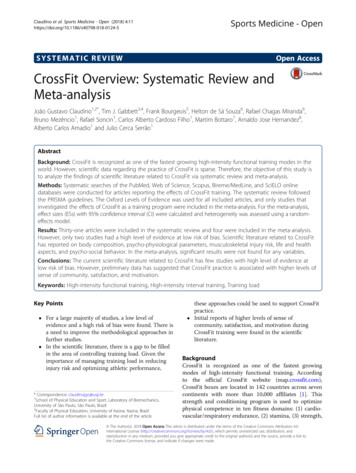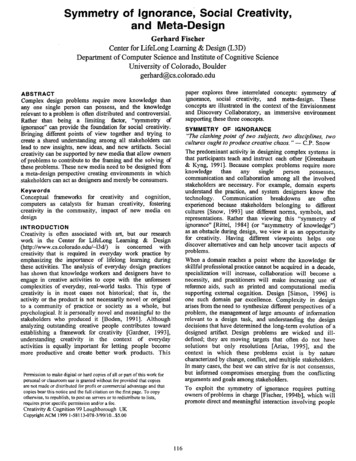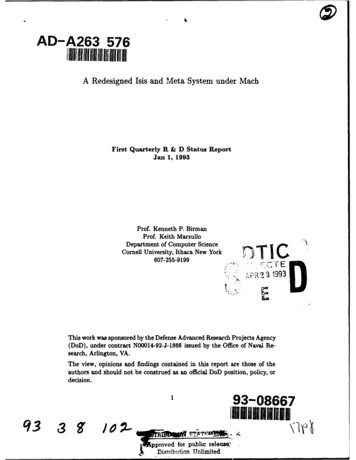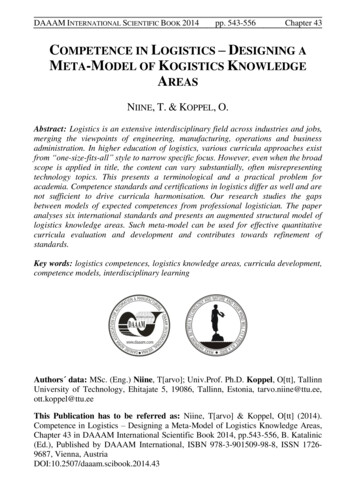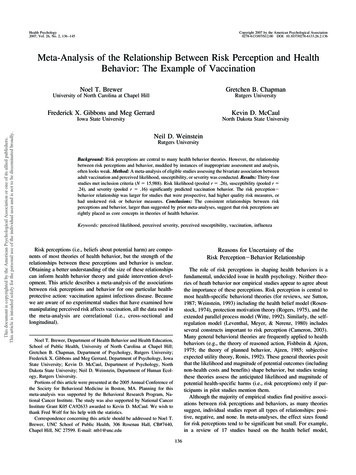
Transcription
Health Psychology2007, Vol. 26, No. 2, 136 –145Copyright 2007 by the American Psychological Association0278-6133/07/ 12.00 DOI: 10.1037/0278-6133.26.2.136This document is copyrighted by the American Psychological Association or one of its allied publishers.This article is intended solely for the personal use of the individual user and is not to be disseminated broadly.Meta-Analysis of the Relationship Between Risk Perception and HealthBehavior: The Example of VaccinationNoel T. BrewerGretchen B. ChapmanUniversity of North Carolina at Chapel HillRutgers UniversityFrederick X. Gibbons and Meg GerrardKevin D. McCaulIowa State UniversityNorth Dakota State UniversityNeil D. WeinsteinRutgers UniversityBackground: Risk perceptions are central to many health behavior theories. However, the relationshipbetween risk perceptions and behavior, muddied by instances of inappropriate assessment and analysis,often looks weak. Method: A meta-analysis of eligible studies assessing the bivariate association betweenadult vaccination and perceived likelihood, susceptibility, or severity was conducted. Results: Thirty-fourstudies met inclusion criteria (N 15,988). Risk likelihood (pooled r .26), susceptibility (pooled r .24), and severity (pooled r .16) significantly predicted vaccination behavior. The risk perception behavior relationship was larger for studies that were prospective, had higher quality risk measures, orhad unskewed risk or behavior measures. Conclusions: The consistent relationships between riskperceptions and behavior, larger than suggested by prior meta-analyses, suggest that risk perceptions arerightly placed as core concepts in theories of health behavior.Keywords: perceived likelihood, perceived severity, perceived susceptibility, vaccination, influenzaRisk perceptions (i.e., beliefs about potential harm) are components of most theories of health behavior, but the strength of therelationships between these perceptions and behavior is unclear.Obtaining a better understanding of the size of these relationshipscan inform health behavior theory and guide intervention development. This article describes a meta-analysis of the associationsbetween risk perceptions and behavior for one particular healthprotective action: vaccination against infectious disease. Becausewe are aware of no experimental studies that have examined howmanipulating perceived risk affects vaccination, all the data used inthe meta-analysis are correlational (i.e., cross-sectional andlongitudinal).Reasons for Uncertainty of theRisk Perception Behavior RelationshipThe role of risk perceptions in shaping health behaviors is afundamental, undecided issue in health psychology. Neither theories of heath behavior nor empirical studies appear to agree aboutthe importance of these perceptions. Risk perception is central tomost health-specific behavioral theories (for reviews, see Sutton,1987; Weinstein, 1993) including the health belief model (Rosenstock, 1974), protection motivation theory (Rogers, 1975), and theextended parallel process model (Witte, 1992). Similarly, the selfregulation model (Leventhal, Meyer, & Nerenz, 1980) includesseveral constructs important to risk perception (Cameron, 2003).Many general behavioral theories are frequently applied to healthbehaviors (e.g., the theory of reasoned action, Fishbein & Ajzen,1975; the theory of planned behavior, Ajzen, 1985; subjectiveexpected utility theory, Ronis, 1992). These general theories positthat the likelihood and magnitude of potential outcomes (includingnon-health costs and benefits) shape behavior, but studies testingthese theories assess the anticipated likelihood and magnitude ofpotential health-specific harms (i.e., risk perceptions) only if participants in pilot studies mention them.Although the majority of empirical studies find positive associations between risk perceptions and behaviors, as many theoriessuggest, individual studies report all types of relationships: positive, negative, and none. In meta-analyses, the effect sizes foundfor risk perceptions tend to be significant but small. For example,in a review of 17 studies based on the health belief model,Noel T. Brewer, Department of Health Behavior and Health Education,School of Public Health, University of North Carolina at Chapel Hill;Gretchen B. Chapman, Department of Psychology, Rutgers University;Frederick X. Gibbons and Meg Gerrard, Department of Psychology, IowaState University; Kevin D. McCaul, Department of Psychology, NorthDakota State University; Neil D. Weinstein, Department of Human Ecology, Rutgers University.Portions of this article were presented at the 2005 Annual Conference ofthe Society for Behavioral Medicine in Boston, MA. Planning for thismeta-analysis was supported by the Behavioral Research Program, National Cancer Institute. The study was also supported by National CancerInstitute Grant K05 CA92633 awarded to Kevin D. McCaul. We wish tothank Fred Wolf for his help with the statistics.Correspondence concerning this article should be addressed to Noel T.Brewer, UNC School of Public Health, 306 Rosenau Hall, CB#7440,Chapel Hill, NC 27599. E-mail: ntb1@unc.edu136
This document is copyrighted by the American Psychological Association or one of its allied publishers.This article is intended solely for the personal use of the individual user and is not to be disseminated broadly.RISK PERCEPTION AND VACCINATIONHarrison, Mullen, and Green (1992) reported an effect size r of .15(.10 .20, p .01) for the relationship of perceived likelihood tohealth behavior and of .08 (.01 .19, p .01) for the relationshipof perceived illness severity to health behavior, where the range inparentheses indicate the range of effect sizes across five categoriesof health behaviors and several different research designs. Floyd,Prentice-Dunn, and Rogers (2000), reviewing studies related toprotection motivation theory, reported an effect size r of .20 for 25studies measuring perceived likelihood and .19 for 21 studiesmeasuring perceived severity, both significant at p .001. However, nearly half of the studies in this meta-analysis used intentionsas the outcome variable, not behavior. In another meta-analysisguided by protection motivation theory (Milne, Sheeran, & Orbell,2000), the effect size r for 8 studies using cross-sectional/retrospective designs was .13 (ns) for perceived likelihood and .10(ns) for perceived severity. For 5 studies using prospective designs, these authors reported an effect size r of .12 ( p .01) forperceived likelihood and stated that the effect for perceived severity was not significant. McCaul, Branstetter, Schroeder, and Glasgow (1996) conducted a meta-analysis of mammography screeningand reported an effect size r of .16 ( p .001) for the 19 studiesexamining the perceived likelihood behavior relationship. Janz andBecker (1984) reported that 30 out of 37 studies based on thehealth belief model found significant effects for perceived likelihood. They also reported significant effects for perceived severityfor 24 out of 30 studies. Looking at such data, some researchers(e.g., Leventhal, Kelly, & Leventhal, 1999) have argued that riskperceptions may have little impact on health behavior.Risk Perception DimensionsBefore discussing the methodological issues that may haveproduced these relatively small effect sizes, we need to distinguishamong three types of risk perceptions as shown in Table 1. Healthhazards have many dimensions, but in describing the threat presented by a hazard, nearly all theories focus on only two: thelikelihood of harm if no action is taken and the severity of harm ifno action is taken. The term likelihood is used interchangeably inthis literature with probability, susceptibility and vulnerability.However, in this meta-analysis, we make a distinction betweentwo logically distinct, though overlapping, concepts: likelihood ofharm and susceptibility to illness. We define the first concept,137likelihood, as one’s probability of being harmed by a hazard undercertain behavior conditions. It is represented by the question“What is the likelihood that you will get the flu this year if youdon’t get a flu shot?” The term susceptibility is often used interchangeably with likelihood, but we use it here to denote riskquestions that appear to address different issues. These questionsemphasize individual resistance or constitutional vulnerability, asin the questions “Do you get the flu easily?” and “Are you morelikely to get the flu than other people?” Susceptibility to a diseaseshould influence the likelihood of developing that disease, butbeing susceptible to an illness does not necessarily mean that theabsolute probability of that illness is large. These two concepts aredistinct from a third issue, “severity,” or “seriousness.” We definethis third concept as the extent of harm a hazard would cause. It isrepresented by the question “How serious a disease is the flu?”Thus, our meta-analysis addresses three perceived risk dimensions:the likelihood of harm if no action is taken, susceptibility to harmif no action is taken, and the severity of harm if no action is taken.An additional risk perception, the perceived risk if one does takesome health-protective action, is also clearly relevant to healthbehavior. However, it reflects a combination of beliefs about boththe likelihood of the risk if there is no action and the effectivenessof the precaution (Weinstein, 1993). Because beliefs about the riskgiven preventive action are seldom reported, we did not includethis concept in our meta-analysis.Conditioned Risk QuestionsThe empirical literature linking risk perceptions with behavior iscompromised by methodological problems, some so severe thatmany studies need to be eliminated from meta-analyses (Brewer,Weinstein, Cuite, & Herrington, 2004; Weinstein & Nicolich,1993; Weinstein, Rothman, & Nicolich, 1998). A major problemin testing whether risk perception motivates action is the failure tocondition the risk question on not taking action. For example, ifone is interested in testing the idea that a high perceived likelihoodof getting influenza motivates influenza vaccination, one needs toknow a person’s perception of what the probability would be if heor she does not get vaccinated. In a prospective study, when peopleare simply asked about their (unconditioned) probability of gettingthe flu, some may say that their risk is low because they neverseem to get the flu. Yet, others may say that their risk is lowTable 1Three Dimensions of Perceived RiskDimensionDescriptionPerceived likelihoodThe probability that one will be harmedby the hazardPerceived susceptibilityAn individual’s constitutional vulnerabilityto a hazardThe extent of harm a hazard would causePerceived severityExampleImagine that the flu shot this year is unavailable and you aretherefore unable to get the shot this fall. Given that you have hadno shot, what would say is the likelihood that you would get theflu this winter? (Chapman & Coups, 2006)If I don’t get immunized, there is a high chance of me getting flu[or pneumonia]. (Madhavan, Rosenbluth, Amonkar, Fernandes, &Borker, 2003)I get sick more easily than other people my age. (Nexoe, Kragstrup,& Sogaard, 1999)Influenza can cause death. (Nichol, Lofgren, & Gapinski, 1992)If I had influenza, I would not be able to manage daily activities.(Zimmerman et al., 2003)
BREWER ET AL.This document is copyrighted by the American Psychological Association or one of its allied publishers.This article is intended solely for the personal use of the individual user and is not to be disseminated broadly.138because they plan to get vaccinated, so their answer anticipates theeffect of the vaccination on their risk. The risk perceptions described by the second group are the expected consequence ofvaccination, not what they think their risk would be if they did notget vaccinated. Consequently, survey responses sometimes underestimate what people who plan to act think their risk would bewithout action. As a result, the observed perceived risk behaviorassociation will underestimate the true association between perceived risk without behavior and the behavior itself. The latter isthe quantity that should be examined.A second serious methodological problem is the use of unconditional risk questions in cross-sectional studies. Such studiescompare the perceptions of people who have been vaccinated withthe perceptions of people who have not. But the risk perceptions ofthe former group—in response to an unconditioned question suchas, “What is your likelihood of getting the flu?”—will reflect theirawareness of having received a vaccination (Brewer et al., 2004).If the vaccine is seen to be highly effective, the same theories thatpredict a positive association between risk likelihood and subsequent action would predict a negative association in crosssectional data (i.e., that people who have received the vaccinethink their likelihood is lower than those who have not received thevaccine). This negative association would not mean that low risklikelihood motivates vaccination! Unconditioned risk questions incross-sectional analyses will underestimate the relationship between risk perceptions and behavior. (Because nearly all the studies that were excluded from this meta-analysis for using unconditioned risk questions also had other problems, we were unable totest this supposition.)Whether or not risk questions need to be conditioned on nottaking a precaution depends on whether it is expected to changeone’s risk. Vaccination mainly changes likelihood. In contrast,mammography can change severity (by diagnosing breast cancer atan earlier stage), but it does not reduce the likelihood of disease.Consequently, perceived likelihood of the infectious disease (butnot perceived severity) needs to be conditioned on not beingvaccinated. Perceived severity of breast cancer (but not perceivedlikelihood) needs to be conditioned on not receiving a mammogram. Perceived susceptibility, as we are using the term, refers tobeliefs about a general constitutional resistance that is independentof particular preventive actions, rather than a temporary state, so itdoes not need to be conditioned on no vaccination. (We located nostudies in our search of the literature that conditioned perceivedsusceptibility on engaging in a health behavior.)The meta-analyses carried out by Harrison et al. (1992) andFloyd et al. (2000) and the cross-sectional studies examined byMilne et al. (2000) included studies that should have used conditional questions to measure risk likelihood. The authors do notreveal which studies included in these reviews did or did not useconditional risk likelihood questions. Consequently, it is likely thatthey underestimated the risk likelihood behavior relationship.Other Risk Question ProblemsRisk questions often have other weaknesses. One problem is thatthe risk question’s referent is ambiguous or that it refers to peoplein general (“How serious is the flu?”) rather than to the respondent(“How serious would it be if you got the flu?”). Social cognitivetheories of individual health behavior are constructed in terms of aperson’s beliefs about himself or herself, not a broader populationcategory. Responses to a question referring specifically to therespondent are more likely to be associated with the respondent’sown behavior. Time frame is often missing from risk likelihoodquestions (i.e., “What is the chance that you will get the flu?”rather than “What is the chance that you will get the flu thisyear?”). This can result in added noise in responses if differentrespondents think about different time frames. Susceptibility questions sometimes refer to illness in general (“I get sick more oftenthan other people”) rather than to the specific illness under consideration (“I don’t seem to have much resistance to the flu”).More specific questions are more likely to be associated with thespecific vaccination behavior under study.In selecting studies for this meta-analysis, we excluded findingsabout risk likelihood if a cross-sectional study did not use alikelihood question conditioned on not being vaccinated becausethe finding is uninterpretable. (However, if the likelihood questionreferred to people in general— e.g., “A lot of people get the flueach year”—we did not require it to be conditioned because doingso would be unlikely to change response.) The other methodological issues mentioned earlier were incorporated into a study qualityscore rather than serving as exclusion criteria. Even with thisrestriction, risk perception measures in the literature take manyforms, some of which more faithfully represent the concepts thanothers. Examples of the range of questions encountered in thisreview and included in this meta-analysis are shown in Table 1.Risk Perceptions and Different Health BehaviorsThe importance of risk perceptions to health behavior undoubtedly varies across behaviors. Risk perceptions are probably moreimportant for behaviors, such as sunscreen use, that are intended toreduce a specific health threat and are probably less important forbehaviors, such as exercise and diet, that have a wide range ofhealth and nonhealth consequences. Risk perceptions are probablymore important when people make individual decisions about abehavior with relatively diffuse external influences, as in sunscreen use, than when strong external influences are present, aswith physician recommendations for cancer screening tests. Whenit is easy to carry out the health behavior, there is likely to be astronger association between perceptions and behavior than whenit is difficult to carry out the behavior.We selected adult vaccination against infectious disease as thefocal health behavior for the current meta-analysis. It is a discretebehavior used to decrease the risk of a specific health threat.Strengthening the possible effect of risk perceptions on this behavior, vaccination behavior is relatively easy to carry out. Weakening the risk perception vaccination relationship, vaccinationbehavior sometimes reflects physician practice (the physician bothrecommends the vaccine and delivers it during a single patientvisit) rather than the independent initiative of the recipient.This meta-analysis was designed to test the hypotheses thathigher perceived illness likelihood, perceived illness susceptibility,and perceived illness severity are associated with greater vaccination behavior and to determine the strength of any associations thatwere found. In addition, we looked at several factors that mightmodify the strength of the associations, including both substantiveissues (type of illness, population vaccinated) and methodologicalissues (study quality, ceiling or floor effects on variables). The
RISK PERCEPTION AND VACCINATIONresults of this meta-analysis will help us to understand better therole that risk perception should play in theories of health behavior.MethodThis document is copyrighted by the American Psychological Association or one of its allied publishers.This article is intended solely for the personal use of the individual user and is not to be disseminated broadly.Study SelectionTo identify articles to include in the meta-analysis, we used a two-stagescreening process. In the first stage, we identified articles and papers thatexamined the risk perception and vaccination behavior of adults. Weexcluded childhood vaccination from the present analysis because it represents a surrogate decision (parent judging risks and deciding aboutvaccination on behalf of the child). We searched PsycINFO and MEDLINEfor articles published between the beginning of the databases and August2004 whose title, abstract, or keywords included reference to both vaccination (i.e., vaccin* or immuniz* or innoculat* or shot) and perceived risk(perceived risk or risk perception* or perception of *risk or perceivedlikelihood or perceived susceptibility or perceived severity or
Noel T. Brewer, Department of Health Behavior and Health Education, School of Public Health, University of North Carolina at Chapel Hill; Gretchen B. Chapman, Department of Psychology, Rutgers University; Frederick X. Gibbons and Meg Gerrard, Department of Psychology, Iowa State University; Kevin D.
